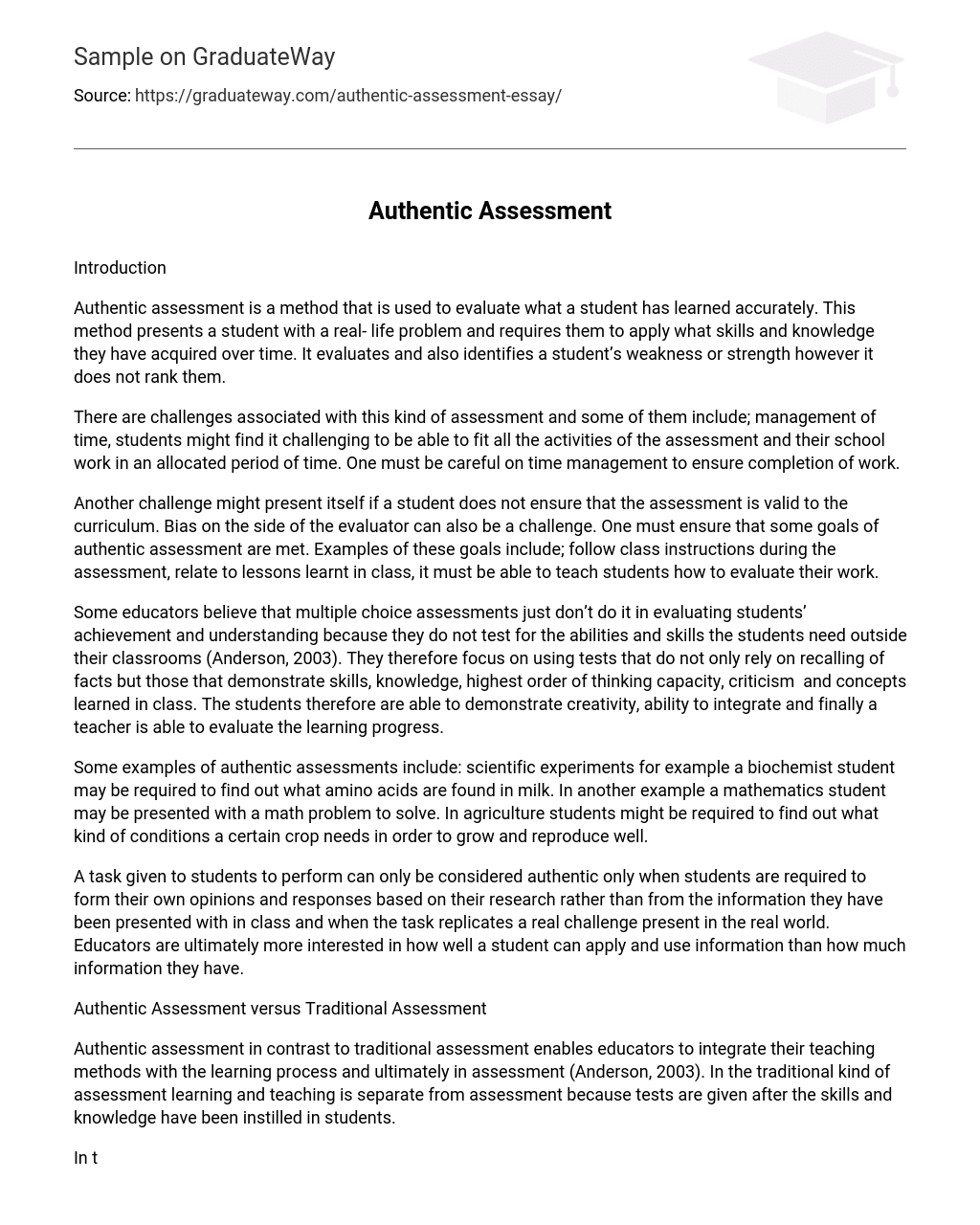Introduction
Authentic assessment is a method that is used to evaluate what a student has learned accurately. This method presents a student with a real- life problem and requires them to apply what skills and knowledge they have acquired over time. It evaluates and also identifies a student’s weakness or strength however it does not rank them.
There are challenges associated with this kind of assessment and some of them include; management of time, students might find it challenging to be able to fit all the activities of the assessment and their school work in an allocated period of time. One must be careful on time management to ensure completion of work.
Another challenge might present itself if a student does not ensure that the assessment is valid to the curriculum. Bias on the side of the evaluator can also be a challenge. One must ensure that some goals of authentic assessment are met. Examples of these goals include; follow class instructions during the assessment, relate to lessons learnt in class, it must be able to teach students how to evaluate their work.
Some educators believe that multiple choice assessments just don’t do it in evaluating students’ achievement and understanding because they do not test for the abilities and skills the students need outside their classrooms (Anderson, 2003). They therefore focus on using tests that do not only rely on recalling of facts but those that demonstrate skills, knowledge, highest order of thinking capacity, criticism and concepts learned in class. The students therefore are able to demonstrate creativity, ability to integrate and finally a teacher is able to evaluate the learning progress.
Some examples of authentic assessments include: scientific experiments for example a biochemist student may be required to find out what amino acids are found in milk. In another example a mathematics student may be presented with a math problem to solve. In agriculture students might be required to find out what kind of conditions a certain crop needs in order to grow and reproduce well.
A task given to students to perform can only be considered authentic only when students are required to form their own opinions and responses based on their research rather than from the information they have been presented with in class and when the task replicates a real challenge present in the real world. Educators are ultimately more interested in how well a student can apply and use information than how much information they have.
Authentic Assessment versus Traditional Assessment
Authentic assessment in contrast to traditional assessment enables educators to integrate their teaching methods with the learning process and ultimately in assessment (Anderson, 2003). In the traditional kind of assessment learning and teaching is separate from assessment because tests are given after the skills and knowledge have been instilled in students.
In the authentic mode of assessment the authentic tasks doubles as a means of assessing and a vehicle used to enhance enable learning. For example when students are presented with a task, they learn during the problem solving and the results obtained are used for assessment and the educator in this case is facilitating the learning process.
There are many differences between authentic and traditional assessment methods but it is important to note that each kind is equally important in producing an all- round and well informed professionals. Each model can not do without the other; they
compliment each other. Some of the differences include; while traditional assessment relies on memorization and recalling of answers, authentic assessment encourages thinking in order to generate answers.
Traditional assessment methods aim to measure whether students have acquired past knowledge while authentic methods aim to ensure that the students develop skills. Curriculum orders on what to be assessed in traditional assessment while in authentic assessment, the tasks allocated directs the curriculum. Traditional assessment relies on what knowledge has been acquired while authentic assessment relies on how the knowledge is to be acquired.
Another difference is that authentic assessment evokes and instills cooperation among students something not seen in a traditional assessment method which evokes competition. Authentic methods prepare the students by giving them a snap- shot of the complicated situations in a professional world.
Advantages of authentic assessment over traditional assessment
Some of the advantages associated with authentic assessment are; this method encourages collaboration and cooperation with teachers, students and society. This way more knowledge, skills and experiences are shared giving better results. This method of assessment also focuses on integration of knowledge and analysis of skills (Luongo- Orlando, 2003). Creativity is encouraged in authentic assessment unlike in traditional assessment.
Authentic assessment promotes the development of both oral and written skills used in presentation it also shows a direct match of assessment, objectives of learning and instructional activities. Over time integration of learning is emphasized in authentic assessment (Luongo- Orlando, 2003).
Another benefit of this type of assessment is that students can assume an active role in the process of assessment which can lead to less anxiety and also enhance self esteem. It can also be advantageous in the fact that the technique is applicable to students of varying academic ability and cultural backgrounds. The tasks given are more interesting and they reflect on the daily lives of the students and therefore a student can develop as more positive attitude towards school.
References
Luongo- Orlando, K., (2003), Authentic assessment: designing performance- based tasks. London; Pembroke Publishers.
Bennet, W. J., Cribb, J., Chester, Jr. F. E., (1999), The educated child: a parents guide from preschool through eighth grade. New York, NY; Simon & Schuster.
Anderson, L. W., (2003), Classroom assessment: enhancing the quality of teacher decision making. London; Lawrence Erlbaum.





